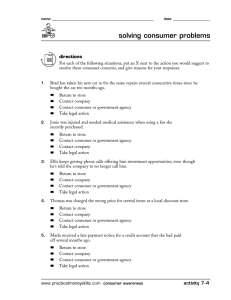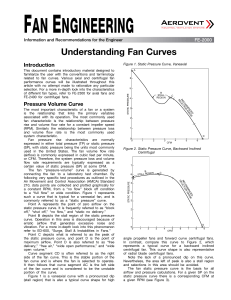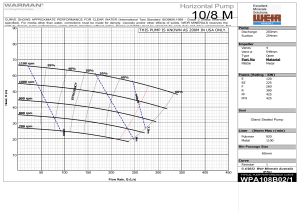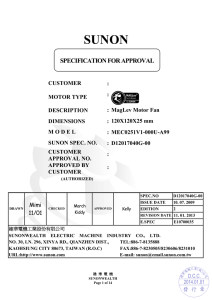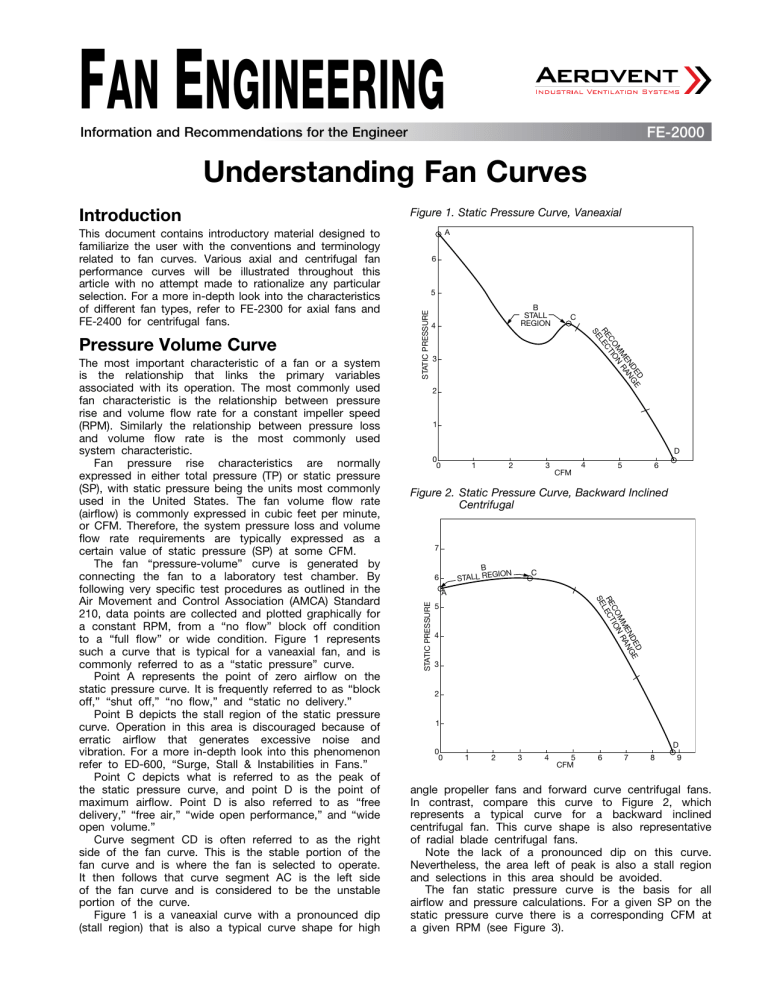
FAN ENGINEERING
FE-2000
Information and Recommendations for the Engineer
Understanding Fan Curves
5
B
STALL
REGION
4
C
3
2
1
D
0
0
1
2
3
CFM
4
5
6
Figure 2. Static Pressure Curve, Backward Inclined
Centrifugal
7
B
ION
STALL REG
6
C
A
D
DE GE
EN AN
MM N R
CO IO
RE ECT
L
SE
The most important characteristic of a fan or a system
is the relationship that links the primary variables
associated with its operation. The most commonly used
fan characteristic is the relationship between pressure
rise and volume flow rate for a constant impeller speed
(RPM). Similarly the relationship between pressure loss
and volume flow rate is the most commonly used
system characteristic.
Fan pressure rise characteristics are normally
expressed in either total pressure (TP) or static pressure
(SP), with static pressure being the units most commonly
used in the United States. The fan volume flow rate
(airflow) is commonly expressed in cubic feet per minute,
or CFM. Therefore, the system pressure loss and volume
flow rate requirements are typically expressed as a
certain value of static pressure (SP) at some CFM.
The fan “pressure-volume” curve is generated by
connecting the fan to a laboratory test chamber. By
following very specific test procedures as outlined in the
Air Movement and Control Association (AMCA) Standard
210, data points are collected and plotted graphically for
a constant RPM, from a “no flow” block off condition
to a “full flow” or wide condition. Figure 1 represents
such a curve that is typical for a vaneaxial fan, and is
commonly referred to as a “static pressure” curve.
Point A represents the point of zero airflow on the
static pressure curve. It is frequently referred to as “block
off,” “shut off,” “no flow,” and “static no delivery.”
Point B depicts the stall region of the static pressure
curve. Operation in this area is discouraged because of
erratic airflow that generates excessive noise and
vibration. For a more in-depth look into this phenomenon
refer to ED-600, “Surge, Stall & Instabilities in Fans.”
Point C depicts what is referred to as the peak of
the static pressure curve, and point D is the point of
maximum airflow. Point D is also referred to as “free
delivery,” “free air,” “wide open performance,” and “wide
open volume.”
Curve segment CD is often referred to as the right
side of the fan curve. This is the stable portion of the
fan curve and is where the fan is selected to operate.
It then follows that curve segment AC is the left side
of the fan curve and is considered to be the unstable
portion of the curve.
Figure 1 is a vaneaxial curve with a pronounced dip
(stall region) that is also a typical curve shape for high
6
D
DE GE
EN AN
M R
M N
CO TIO
RE LEC
SE
Pressure Volume Curve
A
STATIC PRESSURE
This document contains introductory material designed to
familiarize the user with the conventions and terminology
related to fan curves. Various axial and centrifugal fan
performance curves will be illustrated throughout this
article with no attempt made to rationalize any particular
selection. For a more in-depth look into the characteristics
of different fan types, refer to FE-2300 for axial fans and
FE-2400 for centrifugal fans.
Figure 1. Static Pressure Curve, Vaneaxial
STATIC PRESSURE
Introduction
5
4
3
2
1
0
0
D
1
2
3
4
5
CFM
6
7
8
9
angle propeller fans and forward curve centrifugal fans.
In contrast, compare this curve to Figure 2, which
represents a typical curve for a backward inclined
centrifugal fan. This curve shape is also representative
of radial blade centrifugal fans.
Note the lack of a pronounced dip on this curve.
Nevertheless, the area left of peak is also a stall region
and selections in this area should be avoided.
The fan static pressure curve is the basis for all
airflow and pressure calculations. For a given SP on the
static pressure curve there is a corresponding CFM at
a given RPM (see Figure 3).
Figure 5. Static Pressure/Horsepower Curve
Backward Inclined Centrifugal
7
5
6
6
4
5
3
2
P
STATIC PRESSURE
7
BH
STATIC PRESSURE
6
5
4
4
3
3
2
2
BHP
Figure 3. Static Pressure Curve, Vaneaxial
1
SP
1
1
2
3
CFM
4
5
6
0
0
Simply locate some unit of pressure on the left hand
SP scale and project a horizontal line to the point of
intersection on the static pressure curve. From the point
of intersection project a vertical line to the bottom CFM
scale to establish the corresponding airflow at that
particular speed. In this example a static pressure of
three units results in a CFM of 4.71 units.
Brake Horsepower Curve
Having established a static pressure (SP) and an airflow
(CFM), an operating brake horsepower (BHP) can be
established (Figure 4).
6
12
5
10
4
8
BH
P
3
2
3
4
5
CFM
6
7
8
9
Operating Point
The operating point (point of operation or design point)
is defined as the fan pressure rise (SP)/volumetric flow
rate (CFM) condition where the fan and system are in a
stable equilibrium. This corresponds to the condition at
which the fan SP/CFM characteristic intersects the
system pressure loss/flow rate characteristics.
Figure 6 illustrates this fan/system operating point using
the centrifugal fan performance curve from Figure 5.
Figure 6. Fan/System Operating Point,
Backward Inclined Centrifugal
6
7
7
6
6
SP
2
3
CFM
4
5
6
SYSTEM
LINE
OPERATING
POINT
4
3
2
1
0
0
5
4
3
2
SP
FAN ENGINEERING – FE-2000
5
BHP
2
P
BH
1
By adding the BHP curve to the static pressure curve
from Figure 3 we complete the fan performance curve.
To determine BHP simply extend vertically the CFM point
established in Figure 3 until it intersects the BHP curve.
Draw a horizontal line from this point of intersection to
the right to the BHP scale to establish a BHP of 7.27
units, which corresponds to the previously established
performance of 4.71 CFM units at 3.0 SP units.
Similarly, we can add the BHP curve to the static
pressure curve of the backward inclined centrifugal fan
from Figure 2 to complete that fan performance curve
(Figure 5).
2
2
4
1
0
0
BHP
STATIC PRESSURE
Figure 4. Static Pressure/Horsepower Curve, Vaneaxial
1
1
Even though the performance curves for the vaneaxial
fan and the centrifugal fan have completely different
shapes, the curves are read in the same way. Locate
some unit of pressure on the left hand SP scale (4 units)
and project a horizontal line to the point of intersection
with the SP curve. Projecting downward from this point
of intersection to the CFM scale we establish an airflow
of 6.55 units. Now project vertically upward to intersect
the BHP curve. Project a horizontal line from this point
to the BHP scale and read a BHP of 6.86 units.
STATIC PRESSURE
0
0
1
2
3
4
5
CFM
6
7
8
1
9
INCREASING
RPM
7
6
4
OPERATING
LINE
SYSTEM
LINES
3
4
3
2
2
1
0
0
5
BHP
5
{
SP, FAN PRESSURE RISE – SYSTEM PRESSURE LOSS
6
1
2
3
4
5
CFM
6
7
1
8
9
Combining the fan control curve (Figure 7) with the
system controlled curve (Figure 8) results in a fan/system
controlled curve having an “operating region” as shown
in Figure 9.
Figure 9. Variable Fan/System Characteristic Curve
Backward Inclined Centrifugal
7
SP
2
3
4
5
CFM
6
7
8
9
These speed changes represent an example of fan
control that can be accomplished through drive changes
or a variable speed motor.
Another way to present an “operating line” is to add
a damper, making the system the variable characteristic.
By modulating the damper blades, new system lines are
created resulting in an operating line along the fan
curve. This can be seen graphically in Figure 8.
4
OPERATING
REGION
SYSTEM
LINES
3
2
1
0
0
1
2
3
4
5
CFM
6
4
3
FAN
CHARACTERISTICS
2
5
BHP
5
SP
1
1
6
P
2
1
0
0
3
6
BH
2
4
7
{
P
SP
INCREASING
SPEED (RPM)
3
5
BHP
BH
4
SYSTEM
LINE
OPERATING
LINE
7
{
P
5
SP, FAN PRESSURE RISE – SYSTEM PRESSURE LOSS
P
BH
6
BH
6
SP
SP, FAN PRESSURE RISE – SYSTEM PRESSURE LOSS
Figure 7. Variable Fan Characteristic Curve,
Backward Inclined Centrifugal
7
SP
We can now graphically present an “operating line”
between various fan speeds using the fan/system
operating point data from Figure 6. This results in new
SP curves and BHP curves as shown in Figure 7.
7
P
1. CFM varies as RPM
2. SP varies as RPM2
3. BHP varies as RPM3
Figure 8. Variable System Characteristic Curve,
Backward Inclined Centrifugal
BH
The system line is simply a parabolic curve made up
of all possible SP and CFM combinations within a given
system and is determined from the fan law that SP
varies as RPM2. Another fan law states that CFM varies
as the RPM. Therefore, we can also say that SP varies
as CFM2. Note: Some systems have modulating dampers
which will not follow this parabolic curve.
Sometimes a fan system does not operate properly
according to the design conditions. The measured
airflow in the fan system may be deficient or it may be
delivering too much CFM. In either case, it is necessary
to either speed the fan up or slow it down to attain
design conditions.
Knowing that the fan must operate somewhere along
the system curve, and knowing that it is possible to
predict the fan performance at other speeds by applying
the following fan laws:
7
8
1
9
Conclusion
The foregoing methodology provides the knowledge
necessary to understand fan curves. When used in
conjunction with FE-100, FE-600, FE-2300 and FE-2400,
it provides the user with the working knowledge
necessary to understand the fan performance
characteristics and capabilities of different fan equipment.
WWW.AEROVENT.COM
3
WWW.AEROVENT.COM
5959 Trenton Lane N. | Minneapolis, MN 55442 | Phone: 763-551-7500 | Fax: 763-551-7501
©2018 Twin City Fan Companies, Ltd.
